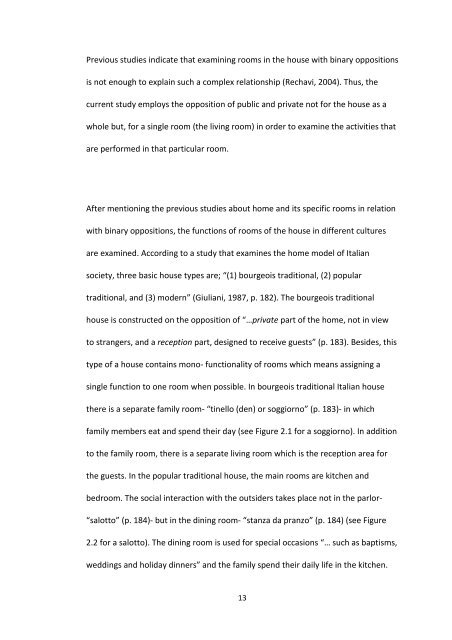private and public use of the living room - Bilkent University
private and public use of the living room - Bilkent University
private and public use of the living room - Bilkent University
You also want an ePaper? Increase the reach of your titles
YUMPU automatically turns print PDFs into web optimized ePapers that Google loves.
Previous studies indicate that examining <strong>room</strong>s in <strong>the</strong> ho<strong>use</strong> with binary oppositions<br />
is not enough to explain such a complex relationship (Rechavi, 2004). Thus, <strong>the</strong><br />
current study employs <strong>the</strong> opposition <strong>of</strong> <strong>public</strong> <strong>and</strong> <strong>private</strong> not for <strong>the</strong> ho<strong>use</strong> as a<br />
whole but, for a single <strong>room</strong> (<strong>the</strong> <strong>living</strong> <strong>room</strong>) in order to examine <strong>the</strong> activities that<br />
are performed in that particular <strong>room</strong>.<br />
After mentioning <strong>the</strong> previous studies about home <strong>and</strong> its specific <strong>room</strong>s in relation<br />
with binary oppositions, <strong>the</strong> functions <strong>of</strong> <strong>room</strong>s <strong>of</strong> <strong>the</strong> ho<strong>use</strong> in different cultures<br />
are examined. According to a study that examines <strong>the</strong> home model <strong>of</strong> Italian<br />
society, three basic ho<strong>use</strong> types are; “(1) bourgeois traditional, (2) popular<br />
traditional, <strong>and</strong> (3) modern” (Giuliani, 1987, p. 182). The bourgeois traditional<br />
ho<strong>use</strong> is constructed on <strong>the</strong> opposition <strong>of</strong> “…<strong>private</strong> part <strong>of</strong> <strong>the</strong> home, not in view<br />
to strangers, <strong>and</strong> a reception part, designed to receive guests” (p. 183). Besides, this<br />
type <strong>of</strong> a ho<strong>use</strong> contains mono- functionality <strong>of</strong> <strong>room</strong>s which means assigning a<br />
single function to one <strong>room</strong> when possible. In bourgeois traditional Italian ho<strong>use</strong><br />
<strong>the</strong>re is a separate family <strong>room</strong>- “tinello (den) or soggiorno” (p. 183)- in which<br />
family members eat <strong>and</strong> spend <strong>the</strong>ir day (see Figure 2.1 for a soggiorno). In addition<br />
to <strong>the</strong> family <strong>room</strong>, <strong>the</strong>re is a separate <strong>living</strong> <strong>room</strong> which is <strong>the</strong> reception area for<br />
<strong>the</strong> guests. In <strong>the</strong> popular traditional ho<strong>use</strong>, <strong>the</strong> main <strong>room</strong>s are kitchen <strong>and</strong><br />
bed<strong>room</strong>. The social interaction with <strong>the</strong> outsiders takes place not in <strong>the</strong> parlor-<br />
“salotto” (p. 184)- but in <strong>the</strong> dining <strong>room</strong>- “stanza da pranzo” (p. 184) (see Figure<br />
2.2 for a salotto). The dining <strong>room</strong> is <strong>use</strong>d for special occasions “… such as baptisms,<br />
weddings <strong>and</strong> holiday dinners” <strong>and</strong> <strong>the</strong> family spend <strong>the</strong>ir daily life in <strong>the</strong> kitchen.<br />
13
















